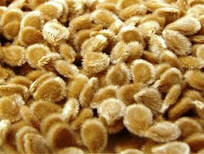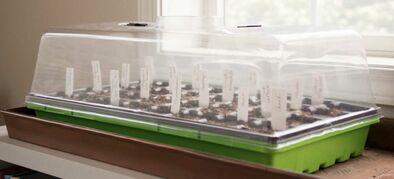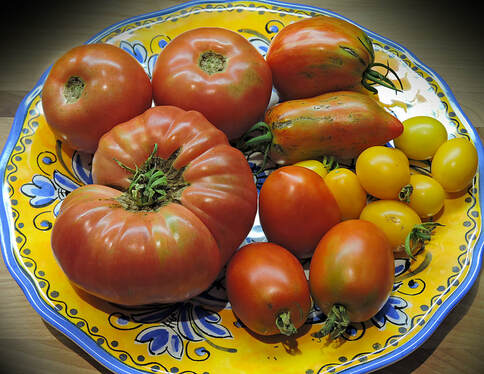|
Continued from Part 1... With the advent of this international distribution of peeled tomatoes (pelati), the ancient fruit finally came back to the Americas... not via its neighbor, Mexico, but the long way around, through Italy and Europe. But there are over 7,500 tomato varieties grown for various purposes. Heirloom tomatoes are becoming more and more popular as home gardeners and organic farmers that they have more variety and develop incredible flavor. There is more disease resistance with hybrid tomatoes, however. The categories of tomatoes is as follows:  Globe tomatoes are the shape of commercially produced tomatoes, but is also a shape category for heirloom tomato types. They are used for slicing for sandwiches, eating fresh or for wedges added to salads.  Beefsteak tomatoes are very large tomatoes where one slice would fit a large sandwich. They usually have very muscular shoulders and have arguably the sweetest taste. Thick slices work well for sandwiches or caprese. Some varieties can produce fruit weighing up to several pounds.  Oxheart tomatoes can range in from small to as big as beefsteaks, and are shaped like large heart or strawberry. Perfect salad tomato.  Plum-Shaped tomatoes, are plum shaped and are often called Paste tomatoes, but not all plum shapes have the meaty interior of a paste tomato. Some varieties can grow quite long like a horned pepper. Fleshy ones, like the D.O.P protected San Marzano, are used in sauces, while other types are useful in salads.  Pear-Shaped tomatoes can be either a paste type or a smaller one with less flesh. They come in a wide variety of colors--red, orange, purple, yellow--and can make a great statement in salads and pasta recipes.  Cherry tomatoes are small and typically about 1" around. The flavor is usually very sweet and are usually eaten whole or halved in salads.  Grape tomatoes, are much smaller than Cherry tomatoes, as small as a blueberry or currants, for use in salads.  Campari tomatoes are sweet and typically come with the vine still attached in a cluster. They can range from red to purple to orange. They are juicy, have low acidity, are bigger than cherry tomatoes, but are smaller than plum tomatoes.  Ribbed tomatoes are typically large and can come in a variety of colors and varieties. In Italy, this is one of the most common types of tomatoes available. They can be meaty like a beefsteak, but always juicy. Vesuvio Piennolo has an elongated, oval shape with a pointed tip (spongillo). The skin is thick and the flesh is firm with a sweet, tangy flavor. It is commonly thought of as a long storage tomato and is seen throughout the Campania region hanging in home gardeners' sheds or garages as bunches, lasting from September throughout most of the winter months. They are also a common tomato being sold in hanging bunches in outdoor markets. The Piennolo is one of the most prized tomatoes in southern Italy. Most types of tomato come in a variety of colors: deep red, pink-red, purple-pink, deep-purple, green, striped, yellow, pale yellow, ivory colored, orange and "black" (a very dark purple). The color of tomatoes can generally be seen as an indicator of flavor: Reds are sweet and higher acidity Pink can be sweeter than red and milder Yellow/Orange being sweet or fruity with medium to low acidity Pale Colors being milder with less acid Darker Black/Purple have high acidity and might be more intense and almost smokey in flavor Striped varieties can be tangy, fruity with high acid and sugar levels (great for salsa).  San Marzano Tomatoes San Marzano Tomatoes The Myths about San Marzano Tomatoes The best known tomato for canning became a plum shaped variety grown in the San Marzano region, near Naples. It's no small coincidence that this is in Southern Italy, where 80% of Italian immigrants came from. San Marzano became the go-to tomato for canning over 120 years ago, and is still the primary tomato used in canned tomatoes--and even for the production of sun dried tomatoes. San Marzano are almost exclusively canned. Fresh ones can be found in Italy, but almost never in the United States. The San Marzano tomato has DOP protected status by the European Union. DOP stands for Denominazione di Origine Protetta (literally “Protected Designation of Origin”). Look for their seal on a can to make sure they are the real deal. It it says something like "San Marzano Type", it isn't the real thing, which can only be grown in a specific area surrounding Mount Vesuvius. Facts: If you are buying tomato seeds, you will only be able to grow a San Marzano "type" because you cannot match the climate and volcanic rich soils where they are grown in Italy. Although these are thought to be the "best" Italian tomato, they are primarily grown for industrial farming, canning and sun-drying in Italy--mainly because their high acidity helps preserve them in the canning process. Yes, you might find actual San Marzano tomatoes in local markets in the area near Mount Vesuvius where they are grown, but again, they are not the best tomato--even within Italy--in my opinion. You can think of them as the best Italian imported canned tomato for sauces, not the most sweet or best for eating fresh. And don't forget to add some sugar to cut their acidity when using them for sauce. The first Italian cannery was built in 1875 by Francesco Cirio, an early supporter of the San Marzano tomato. His company picked, peeled, packed and shipped canned tomatoes all throughout Italy--and later to America. The reason for it's success is not because it's the best tasting tomato... it's simply because it was developed and hybridized from three other varieties which made it withstand mechanical harvesting techniques put in place in the late 1800s to satisfy the needs of the growing canning industry. Its secret? High acidity! Sort of takes the romance out of thinking the San Marzano is "the best" Italian tomato, doesn't it? No great loss. Truth be told, the San Marzano is so acidic that all great Italian chefs know it needs a handful of sugar to offset the overly high acidic content necessary for long storage and canning. Lucas and I had an "artisinal pizza" once in a town near us where the pizza chef swore he used nothing but "the best San Marzano" imported tomatoes as his sauce. I could tell. By the end of the meal our lips were burning. For some really sweet tomatoes, think Heirloom... Growing Your Own Heirloom Tomatoes It's fairly easy to grow heirloom tomatoes from seed, but a simpler way to get started growing the amazing variety of tastes is to buy heirloom plants in the spring at your local nurseries. Stay away from anything labeled "hybrid". You cannot save seeds from a hybrid tomato--it won't look anything like the mother fruit you took the seed from. Many garden centers nowadays offer Heirloom varieties that you can plant and get a head start on, with the benefit of saving seeds from your biggest and best tasting fruits so you can continue to grow them again year after year. Growing heirloom tomatoes can become part of your family heritage. If you purchase young heirloom plants, buy and plant them just after the danger of frost in your location. Here's a LINK to help you find out the best time for planting based on your zip code in the U.S.. Now, how to plant... First, make sure you are planting in ground that is tilled nice and fluffy. Make sure you have amended it with some nice organics. I like a mix of peat moss (to hold moisture) and compost from my own compost pile. You can buy bagged compost, but stay away from fresh manures... they will burn the plants. You can use any number of organic or non-organic plant foods that have chemicals balanced for growing vegetables that grow fruits. As for planting, here's a great tip. Tomatoes will grow roots all along their stems if you let them. With young seedlings, pull off the lower leaves and plant deeply. If I have 12" tall plants, I'll plant them with about 2/3 under ground. This gives them a better start--allowing more roots to grow which will supply more nutrients to your plants--and fruits. I grow my tomatoes upwards onto "quad-pods"--sort of like a four legged tripod. You can make them out of wood or bamboo. As the plants grow, trip off side suckers that grow in the crotch of some leaf joints and tie off the plants to your supports. I plant one tomato plant per corner of my quad-pods, each about 3 feet apart. Don't overcrowd or your plants will sap nutrients from each other and all will be stunted. Indeterminate types keep producing fruit until the autumn frost, while determinate varieties are smaller and produce a set amount, then die. Indeterminates can grow to 8 feet tall, so use tall, strong supports. I don't like wire cages because it's difficult to harvest tomatoes toward the center. With heirlooms, you can try yellow, purple, black, pink, red or even striped varieties. My best all around tasting tomato is called Eva Purple ball--a 3" pink, perfect, pest free tomato. My best beefsteak for taste is Giant Belgium. And I love growing Olivette Juane (a prolific yellow pear shape) and Jersey Devil (a horned, chili pepper shaped sauce tomato). Harvest in the mornings for best flavor. As your fruits come close to ripeness, hold back a bit on watering so you don't dilute the flavors. And watch out for your tomatoes' enemies: the tomato hornworm and chipmunks!  Seed-Saving With heirlooms, label them carefully if you plan to save seeds. Save seeds from your biggest, most blemish free fruits... their genetics will ensure you get a good strain of seeds for next year. First, place the seeds in a plastic cup with water and label the cup as to variety, weight of fruit and any other notes about how they performed in your garden (robust plants, bountiful harvest, pest resistant, blight resistant, etc). Place a wet paper towel cover over the top of the cup and set aside for 1 week. The seeds will ferment and all the slime will be removed from the seeds. After a week or so, rise the seeds carefully, replacing with clean water as you go, until there are only clean seeds in the cup. Remove the seeds from the water and place into labeled coffee filters and set somewhere to dry. Package in paper coin envelopes with their names, date saved and notes.  Healthy, fuzzy tomato seeds Healthy, fuzzy tomato seeds You can start your seeds next season about 6-8 weeks before your last frost, indoors, under artificial lights in seed starting trays and pots. I tend to use two sizes during seed starting... a small seed "pack" size pot made out of peat or compressed paper products... and then I transplant deeper into 4" plastic pots. At first, plant seeds very shallow into peat pots (set into large plastic seed starting trays) filled with seed starting mix (sterile) dampened with warm water. Lightly cover with a little soil, patted down firmly. Label each variety to keep track of different types.  Cover with a clear plastic cover for the first week or so until you see tiny sprouts, then remove the cover. After another week or so you should see two "true leaves" appear, that look just like adult tomato leaves. This is when you can start using tomato food to help them grow. Keep a timer on your grow lights to mimic sunup and nighttime light patterns. Water each tray regularly to keep the soil moist. Keep the lights close to (but not touching) the leaves all through the growth process. I keep my grow light on chains and can move the light upwards as the plants get taller. When they are about 4" tall, I keep a small fan blowing across the cellar toward them. This builds sturdy stems by constantly moving them. You can plant your tomatoes in the garden when they are 8-12 inches tall. I set them outside in a protected area to "harden off" to temperature and wind before planting them in my garden beds. Keep them out of too much direct sunlight when hardening them off. Plant each plant into a deep hold, about 2/3 as deep as the plant's height. Mulch well, water on a regular basis (but not too much or some tomatoes will crack or lose flavor). Harvest when they are slightly soft when squeezed, but still firm--preferably in the morning, when their flavor is the sweetest. Heirloom Seed Resources Annies Heirloom Seeds Heirloomseeds.com Seedsavers Exchange Growing Heirloom Tomatoes in Pots Old House Journal Article: How to Grow Heirloom Tomatoes I hope this gives you a better insight into the long, special voyage the tomato has made... from the Andes mountains, across the sea to Spain, Italy and the rest of Europe, then back to the United States with the influx of Italian Immigrants. The tomato is alive and well all over the world, but especially in Italy. They've adopted this little nightshade fruit and made it their own... And in my own family, growing tomatoes has been and always will be part of our Italian heritage. My father taught me how to grow tomatoes and I always looked forward to biting into the sweetness he grew, right off the vine in our humble backyard garden. I have been growing tomatoes in my own gardens ever since I moved out of my Manhattan loft home and studio, and if truth be told, I even grew tomatoes there--on my sun-filled fire escape. I've taught my son to grow tomatoes since he was about 4 years old. He helps start the seeds in our cellar under our grow lights, he plants them in our raised beds, he harvests them, and even knows how to remove the skins by boiling and plunging into ice water and making a great, fresh tomato sauce. Tomatoes are a link to our Italian ancestors and our culture. I highly recommend growing your own heirloom tomatoes. They are called heirlooms for a reason... their seeds will be passed down from generation to generation and become part of your own family's heritage. --Jerry Finzi You may also be interested in... My New Favorite Tomato: Striped Roma San Marzano Tomatoes: Accept no Imitations! Video: Hanging Bunches of Piennolo Tomatoes Video: Canning Tomatoes, Italian Style Worlds' Largest Tomato Making a Great Pizza Sauce My Beautiful Tomato Harvest Ladybug Caprese Insalada Tomato Tree Producing up to 3000 Pounds of Fruit! Are Italian Gardeners Fading Away? Music Video: Home Grow Tomatoes Song! Copyright, Jerry Finzi, Grand Voyage Italy, All rights reserved
|
On AMAZON:
|

















 RSS Feed
RSS Feed

